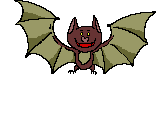|
Main Topic: What is your favorite Halloween Treat? 
October 30th is National Candy Corn Day! Candy corn has been around for more than 100 years. George Renninger, an employee of the Wunderlee Candy Company, invented the popular confection in the 1880s and Wunderlee became the first to produce the candy. The Goelitz Candy Company (now Jelly Belly Candy Company) started producing the confection in 1900 and still produces candy corn today. The process of making candy corn is very similar today, but now machines do most of the work. Manufacturers use a method called the corn starch molding process. A tray containing depressions is filled with corn starch. Candy corn is made from the bottom to the top and in three-color passes. First, the depression is filled one quarter full with yellow syrup and allowed to partially set. Next, the orange syrup is added. The mold is then topped off with the white syrup and is cooled. The candy now can gel together. After is it has finished cooling, the trays are emptied and the little candy corns are ready to be eaten. 

The Tootsie Pop was invented in 1931 by The Sweets Company of America, which changed its name to Tootsie Roll Industries, Inc. in 1966. In 1970, Tootsie Roll Industries aired one of the most famous TV commercials of all time, featuring a boy trying to ascertain how many licks it takes to get to the center of a Tootsie Pop. Along with the two Tootsie Roll commercials, this commercial (albeit in a re-edited 15-second "hook" version) continues to be shown on television today, making them the longest running commercials of all time. (A second, shortened Tootsie Pop commercial was created and first aired in 1996, which also continues to be shown on television today).
The original 1-minute version of the commercial had the boy going up to Mr. Cow and Mr. Fox before going up to Mr. Turtle asking how many licks does it take to get to the center of a Tootsie Pop in which they respond that they bite them instead of licking and suggest asking the next animal. After the 1970 TV commercial, Mr. Owl became the mascot for Tootsie Pops. He appears on the packaging and marketing. 

By the mid-1800s, there were nearly 400 American candy manufacturers that were producing primarily the hard candies often sold in general stores—they were cheap to make, easy to transport, and did not spoil easily. Caramels were made at these small confectioneries as well. In fact, Milton Hershey began his chocolate empire not with chocolate, but with caramel. Hershey was born in 1857 in Pennsylvania, and rather than become a printer, he founded a candy-making business in Lancaster, Pennsylvania. By 1886, he had founded the Lancaster Caramel Company, surely utilizing traditional recipes that were found in many regional cook-books. He learned about chocolate-making because he sought new coatings for his famous caramels. Caramel apples were invented by Dan Walker, a sales representative for Kraft Foods, in the 1950s. 

Popcorn balls were one of the most popular confections in the late nineteenth and early twentieth centuries. Back then, popcorn balls were given to friends, teachers and loved ones as inexpensive gifts and party favors. Elegant, ornate ornaments and decorations made from popcorn balls graced Victorian mantels and doors at the holidays. And popcorn balls flavored with orange and lemon juice, peppermint, honey or molasses appeared frequently at afternoon teas and other social occasions. The first popcorn machine was invented by Charles Cretors of Chicago, Illinois in 1885. Today much of the popcorn you buy at movies and fairs is popped in poppers made by the Cretors family. 

HERSHEY'S MINIATURES chocolate bars were launched in 1939 as the original assortment packaged-candy, featuring America's favorite Hershey-branded candy bars in miniature size. Today, the favorite assortment of HERSHEY'S milk chocolate, HERSHEY'S SPECIAL DARK, HERSHEY'S KRACKEL and HERSHEY'S MR. GOODBAR bars remains. In 2004, the HERSHEY'S MINIATURES brand announced its first line extension - HERSHEY'S MINIATURES NUT LOVERS chocolate bars. 

A "cup" cake in 19th Century America might have been a small cake, but it wasn't necessarily so. They were so called because the ingredients for them were measured in cups instead of weighed, as had been the custom. According to "Baking in America" by Greg Patent, this was revolutionary because of the tremendous time it saved in the kitchen. Whether it was a "cup," "measure" or "number" cake, the shift to measuring from weighing was indeed a significant one, according to "The Oxford Encyclopedia of Food and Drink in America." But it goes on to explain that the cup name had a double meaning because of the practice of baking in small containers -- including tea cups. It was 1919 when Hostess introduced the famous snack cupcake, but it didn't become the cream-filled, squiggle-topped Hostess Cup Cake we know today until 1950. 
Come tell us about your favorite Halloween Treat!! 
FR CANTEEN MISSION STATEMENT~Showing support and boosting the morale of our military and our allies military and the family members of the above. Honoring those who have served before.
Please remember: The Canteen is a place to honor and entertain our troops. The Canteen is family friendly. Let's have fun!  We pray for your continued strength, to be strong in the face of adversity. We pray for your safety, that you will return to your families and friends soon. We pray that your hope, courage, and dignity remain unbroken, so that you may show others the way. God Bless You All ~ Today, Tomorrow and Always
|







